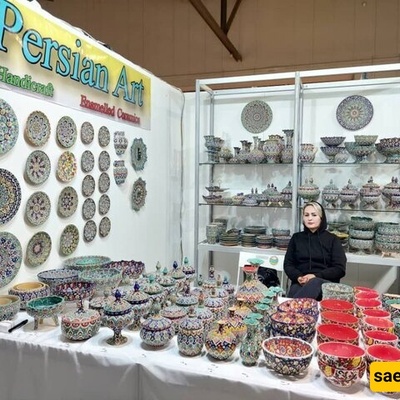The Damam is a double-headed drum played with sticks and hands. It is used in mourning ceremonies, events like music therapy sessions, Ramadan ceremonies, and more. In this section of Saed News, we provide a complete introduction to the Damam instrument.

This instrument, which has African origins, was introduced to southern Iranian ports via sea routes and today is considered one of the main musical instruments of the region. The Damam is used in the folk music of the provinces of Khuzestan, Hormozgan, and Bushehr, but it is most closely intertwined with the culture and music of Bushehr. It is often played alongside instruments such as the cymbals (sanj), horn (boogh), bagpipe (ney-anban), and paired ney (ney jofti).
From ancient depictions, it is evident that at least 4,000 years ago, drums similar to the Damam were found in Mesopotamia and Egypt, some of which have survived to this day. Historically, people considered drums magical and worthy of reverence, playing them to ward off misfortune or summon pure spirits. Drums were also used to announce military news as well as in singing and dancing. The Damam has been part of this tradition throughout history.
The rope tensioning of the Damam is Y-shaped, resembling African and Indian percussion instruments. Apparently, the name "Damam" imitates the sound it produces. Among the percussion instruments of southern Iran, especially in Bushehr and Bandar Ganaveh, the Damam is prominent. It has been used in various ritual ceremonies in southern Iran, including Sanj and Damam performances, Zar rituals, sea-related hums during fishing, “Dam Dam Sahari” (pre-dawn rhythms), and Sebalo ceremonies.

The Damam is a cylinder made from a single piece of wood or rods and sometimes metal, with skins stretched over both ends. The skins are first stretched over rings called "chambereh," made of bamboo or reed. Each instrument has four chambereh—two on each side— which is unique among double-headed drums in Iran, as most have only one ring per side.
The rings and skins are attached to the body of the instrument by a special rope system. The Damam is played with a slightly curved wooden stick (made from palm leaf stalk) and by hand.
Body: Solid wood, rods, or metal
Skin: Goat skin
Chambereh (Rings): Bamboo, reed, wood, or metal rods
Stick (Beater): Palm leaf stalk
Rope: Fibers like hemp or cotton cords
The curved stick is held in the right hand. The right skin is played with the stick, and the left skin is played with the left hand. The right and left hands complement each other rhythmically, creating a kind of rhythmic conversation.
This dialogue is simpler in the ordinary Damam and becomes more complex in the “Ghamber” and “Eshkun” types. The sound of the stick striking the right skin is strong, deep, and loud, while the left hand’s touch on the left skin produces a sharper, higher-pitched sound. The Ghamber Damams bridge the rhythmic flow between ordinary and Eshkun Damams.
Ordinary Damams lay down the main rhythmic base, Ghamber Damams build this base into a rhythmic structure, and the Eshkun Damam improvises and decorates this rhythm. Therefore, the role of the Eshkun Damam is the most complex and important.

One of the most prominent uses of the Damam is in mourning ceremonies during the month of Muharram, performed in groups alongside Sanj and Boogh. It is also used in Yezleh ceremonies with Ney-anban and Ney jofti. When a newly built boat is sent to sea, the Damam is played.
In the past, when unloading cargo from large sailing ships that could not dock, smaller boats called “Tshaleh” were used. African rowers on these boats sang “Nimeh” songs while playing the Damam.
The Damam is also used in “Zar” ceremonies, which are African-derived and locally performed in Bushehr with religious and therapeutic significance.
“Dam Dam Sahari” is another event where the Damam is played—this ceremony wakes people at dawn during Ramadan.
When ships stopped for rest or water, rowers played the Damam while disembarking. As recounted by Captain Haj Hossein Bezan from Bushehr port: “Whenever ships arrived at port to take on water or rest, sailors disembarked to the sound of the Damam, and the same happened when boarding—this refers to the Damam, not the Sanj and Boogh.”
“Sebalo” was a ceremony performed not long ago in Bushehr by African-descended musicians called Sebalos. They had special ceremonies and performed at weddings and important events.
The Damam is a percussion instrument producing sound through the vibration of skins stretched over a cylindrical frame. It is primarily used in southern Iran, especially in Bushehr, Bandar Rig, Bandar Ganaveh, Abadan, Borazjan, Bandar Deyr, Bandar Abbas, and other southern cities.

